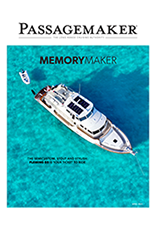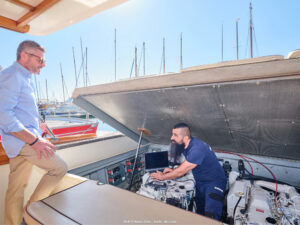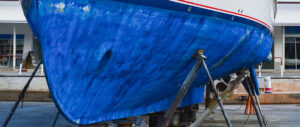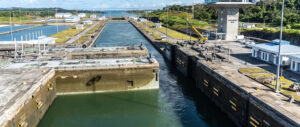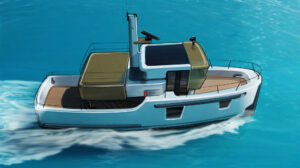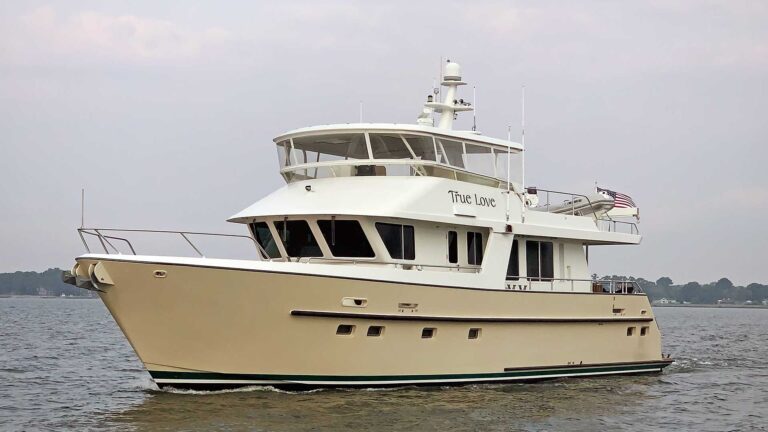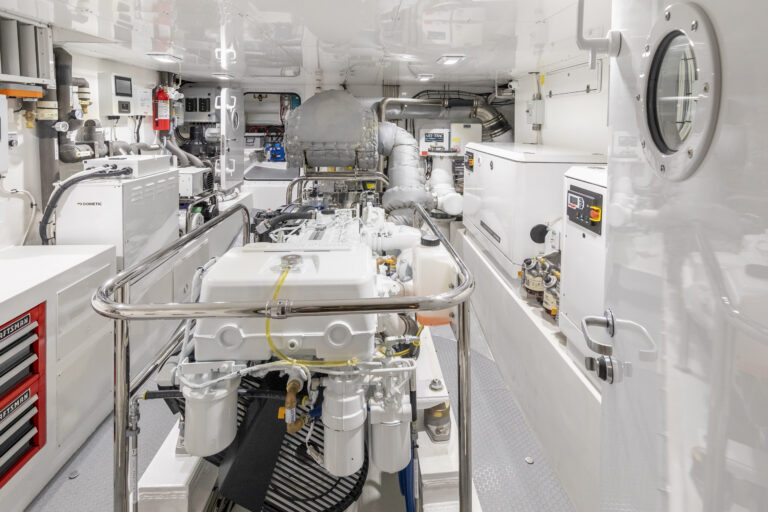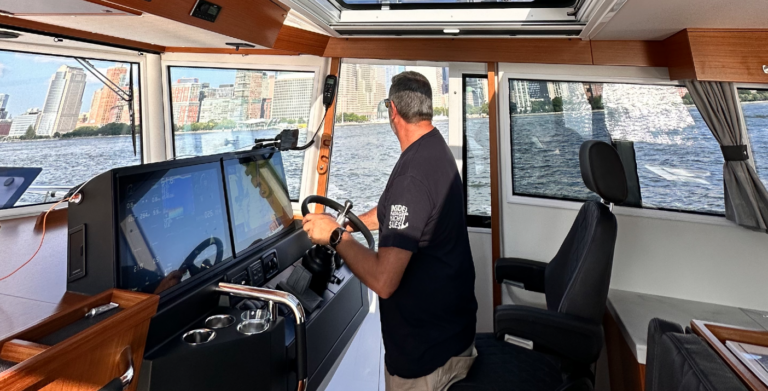The centuries-old dispute over which is more preferable—one or two hulls—boils down to several factors, each with distinct advantages and disadvantages. While the final verdict is usually founded on personal preference and intended use of the vessel, that didn’t stop these two experts on the subject from stepping into the ring for some friendly sparring on the matter.

“I promise to tell the truth, the hull truth, and nothing but the truth…”
Representing Monohulls: David Parkinson
Parkinson grew up racing sailing dinghies in England at a very young age and, as soon as he was able, started racing offshore, eventually completing two Fastnet races, a Sydney Hobart race, and a Transatlantic race. His passion for sailing led to four Atlantic crossings and a circumnavigation. After a brief legal career in London, he sailed to the United States, where he started a yacht delivery business, captaining charter boats in the Bahamas and the Caribbean and, ultimately, running a number of large yachts for private individuals and corporations. Parkinson has also held corporate executive positions with several brand-leading marine electronics manufacturers.
Representing Multihulls: Mike Kiely
Florida yacht broker Mike Kiely is originally from the east end of Long Island, New York, and comes from generations of experienced boaters of both power and sailing yachts. Kiely’s career spans more than 25 years in the marine industry as a national and international sales representative, yacht broker and business development manager. He grew up on powerboats, owned a sailboat and center consoles, and cruised on sailing catamarans. He raced custom-built personal watercraft, and some of his races were featured on ESPN. Kiely also sailed ice boats on the Great South Bay in Long Island at over 40 knots. Today, Kiely leads a team of brokers at Denison Yachting’s Miami office.
On The Docket…
1. SAFETY
Mike Kiely: Catamarans are very stable and have natural buoyancy, making them unsinkable. Yes, they can capsize in a bad accident, but it’s better to be rescued floating on the water’s surface than sinking to the bottom in a monohull. Plus, moving around on a flat deck is much safer than on a deck at an angle.
David Parkinson: Monohulls have much better self-righting capabilities in the event of a worst-case knockdown, particularly sailboats. Once you’re upside down in a catamaran, you stay upside down, and who wants that in the middle of a large ocean? By returning to an upright position you still have full access to onboard safety equipment, life raft, dinghy, flotation devices, Epirbs, strobe lights, etc. to save you in the unlikely event of the boat sinking.

2. SPEED
MK: Cruising catamarans are faster than monohulls, and sailing catamarans can sail half the speed of the wind, depending upon their angle. It’s ideal to be on a boat that can reach high speeds quickly and arrive at your destination in a reliable and timely manner.
DP: Due to their lower wetted surface area, catamarans are certainly faster, but you pay the price with a slapping and uncomfortable ride. Monohull designs work harmoniously with the elements instead of trying to fight them. Sailing catamarans are inefficient upwind and tack very slowly.

3. FUEL
MK: Want to save money on fuel? Get a catamaran. Since catamarans have reduced wetted surface area on their hulls, they are much more fuel efficient. In light winds, they can use just one engine to propel the boat.
DP: True, in flat water, assuming equal number and horsepower of engines. But, not so much in heavier weather, where the higher efficiency of a monohull design presents less resistance.

4. LAYOUT
MK: The biggest perk is having all rooms on the same level. Most cruising cats have a four-cabin layout, popular for charter companies. “Owner versions” typically have three cabins, using one hull as a large cabin, which is great for entertaining. Monohull layouts are inconvenient, and who wants to use a cramped staircase?
DP: Most catamarans have a large central living area with not one but two cramped staircases—one on either side—to get down into the hulls. The spaces in the hulls feel a bit like living in a tube. They’re narrow and can’t accommodate those walkaround double/queen berths commonly found in monohulls. In an emergency, communication with someone in the other hull would be difficult.

5. MANEUVERABILITY
MK: Catamarans are extremely maneuverable with their twin engines. Having two engines about 20 feet apart eliminates the need for a bow thruster. They also have shallow drafts, so you can navigate into places you can’t get to with a monohull, and you can anchor closer to shore.
DP: Monohulls maneuver better because you’re not dealing with two hulls. They can make sharper turns and navigate much more easily through narrow channels and tight spaces. Plus, their higher hull displacements reduce the adverse effects of crosswinds in tight conditions.

6. DOCKING
MK: While it’s easy to dock a catamaran, the unique size doesn’t always fit into a traditional slip, but with some skill and careful planning, there shouldn’t be a problem finding space. You could also anchor or moor the boat and go ashore in the dinghy, which is even easier to dock than a monohull.
DP: Who wants to take two separate boats to shore? A monohull is much easier to dock, takes up less space, and is cheaper to dock, haul and slip.
7. MAINTENANCE
MK: With catamarans, there are two of everything, so there’s certainly a trade-off of maintenance cost to reliability and redundancy. A huge benefit of having two of everything is you have a backup. So you can usually still use the boat if one component isn’t working, such as running on one engine if the other fails.
DP: While redundancy is great, I’ll take reduced maintenance and repair costs any day. Two of everything certainly gives you some backups, but if one of the two hulls “isn’t working,” I doubt you’ll want to take the boat out.
8. STABILITY
MK: Catamarans have little to no heeling due to their weight bearing, and they don’t roll at anchor. Heeling on a monohull with unexpected gusts can be dangerous and uncomfortable, not to mention cause seasickness.
DP: The trade-off, again, is a noisy ride and a quick motion, which many people find uncomfortable in heavier weather. In a monohull sailboat, the heeling action actually provides stability, spills wind from the sails and adds an element of safety.

9. COMFORT
MK: The ability to walk around most of the boat and entertain guests without rocking is more comfortable on a catamaran, making them very family friendly. Did you know that seasickness is slim to none on a catamaran?
DP: Fortunately, I’m not prone to seasickness, but I once felt quite seasick on a sailing catamaran! True, entertaining on a multihull is often more comfortable because the platform is stable. But after a couple of gin and tonics, it doesn’t seem to matter as much for some reason.

10. COST
MK: With a minimum of two of everything, cost can run high. Catamarans have a great resale value and a very low depreciation rate due to their popularity, and they usually sell faster than monohulls. Since most catamarans are not built in the United States, there are delivery costs involved when purchasing the boat.
DP: Multihulls are definitely increasing in popularity and as a result of strong demand they command higher prices in both new and brokerage markets. Maintenance costs, which are significantly higher than for a monohull, need to be factored in when making a buying decision.

